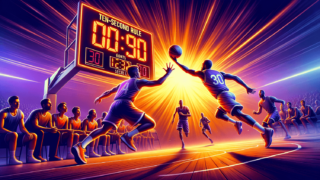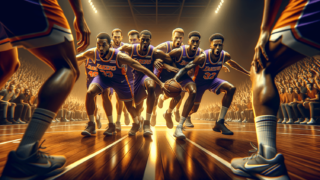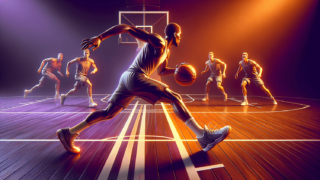
Basketball’s Offensive and Defensive Three-Second Rules
Written by: Basketball Universe
Last updated:

Welcome to the captivating world of basketball, where each second counts, and rules are designed to keep the game both fast-paced and fair! In our blog post ‘Basketball’s Offensive and Defensive Three-Second Rules,’ we will delve into the intricacies of these crucial regulations, breaking down their objectives, implementation, and impact on the game. So, whether you’re a fervent fan, budding baller, or a curious cat, stick around as we decipher these three-second rules, offering you fascinating insights into the dynamic dance between offense and defense on the court!
Basketball’s Offensive and Defensive Three-Second Rules
The offensive three-second rule in basketball forbids an offensive player from remaining inside the opposing team’s free throw lane (also known as the key or paint) for more than three consecutive seconds without actively trying to vacate the area, while their team has possession of the ball. On the other hand, the defensive three-second rule restricts a defender from staying in the opponent’s key for over three consecutive seconds without closely guarding a particular offensive player. These rules are enforced to maintain fair play, ensure consistent offensive and defensive movements, and to prevent illegally advantageous positioning during the game.
Unraveling the Origins of the Three-Second Rules
Understanding the evolution of these pivotal basketball rules is crucial to grasp the fundamental purpose behind their existence. Both the offensive and defensive three-second rules have unique and engaging stories behind their development, and taking a trip down memory lane is always fun!
The Birth of the Offensive Three-Second Rule
Let’s rewind to the early days of basketball, where the game was vastly different from what we know today. Six-foot-ten-inch George Mikan, nicknamed Mr. Basketball, was a dominant force in the 1940s and 50s. His incredible size and skill allowed him to take control of the area beneath the basket, gaining an unfair advantage over opponents. This raised concerns that a one-dimensional offensive approach would prevail, leading to a less competitive game. To level the playing field and promote strategy and diverse play styles, the offensive three-second rule was introduced in 1936.
Emergence of the Defensive Three-Second Rule
Fast forward to the early 2000s, when zone defenses were gaining popularity in the NBA. Teams began employing a defensive tactic where a player, often a taller or more physically imposing athlete, would clog the lane without actually guarding any specific opponent. This heavily disrupted the offensive team’s ability to drive towards the basket or execute their game plan effectively. As a result, the NBA implemented the defensive three-second rule in the 2001-2002 season. The rule helped create better scoring opportunities, maintain healthy competition, and diversify play by promoting man-to-man defense strategies.
Crucial Elements of the Offensive Three-Second Rule
Now that we’ve explored the origins of the offensive three-second rule, it’s time to examine the key aspects that make this regulation an integral part of basketball rules. From grasping the fundamental concept of the restricted area to discovering exceptions and violations, immerse yourself in the details.
Understanding the Restricted Area
The restricted area, commonly known as the key, lane, or paint, is a rectangular zone on the court extending 16 feet from the baseline to the free throw line and 12 or 16 feet wide, depending on the league. The offensive three-second rule applies to this zone, and players must be cautious not to violate it while planning their attack.
Exceptions to the Rule
There are several exceptions and scenarios where the offensive three-second rule is not applicable:
- An offensive player in the act of shooting is exempt from the rule, granting them the time and space to execute their shot.
- If the offensive player has possession of the ball, the rule does not apply since they are actively engaging with the defense.
- The rule is temporarily suspended while a player is cutting through the restricted area.
Offensive Three-Second Violations and Penalties
When a player violates the offensive three-second rule, a whistle is blown, and the ball is turned over to the opposing team. The opposing team is awarded possession at the nearest sideline, handing them an opportunity to initiate their offense.
Diving Deep into the Defensive Three-Second Rule
Balance and fairness are critical in sports, and basketball is no exception. Let’s explore the defensive three-second rule by understanding its implications, pertinent exceptions, and consequences of rule violations.
Counting the Ticking Clock
Most leagues enforce a defensive three-second rule solely on professional levels, such as the NBA, WNBA, and FIBA international competitions. This rule mandates a defender to continually guard an offensive player or be engaged in defending the ball handler. A violation occurs when the defensive player remains in the opponent’s key for three consecutive seconds without closely guarding a specific offensive player. The purpose of this rule is to prevent defenders from planting themselves in the restricted area without actively participating in the game or guarding an opponent.
Exceptions: When the Rule Doesn’t Apply
As with the offensive rule, there are exceptions to the defensive three-second rule:
- When the offensive team is in the act of shooting, the rule is not enforced, and defenders can remain in the lane to try and contest that shot or secure the rebound.
- Defensive players can stay in the lane without actively guarding an opponent when the offensive player with the ball is within the Lower Defensive Box (LDB). The LDB is an area in the key defined by a 16-foot-wide rectangle on each side of the court, extending from the free throw line to the baseline.
Defensive Three-Second Violations and Penalties
When a defensive three-second violation is called, a technical foul is assessed on the violating player’s team. The opposing team is awarded a single free throw, typically taken by the best free throw shooter on the court, and retains possession of the ball after the free throw attempt.
Impact of the Three-Second Rules on Gameplay and Strategies
Both offensive and defensive three-second rules shape modern basketball by dictating tactics, promoting fluid gameplay, and maintaining competitiveness. Grab a seat, as we analyze the profound impact of these rules on the sport we love.
Dynamic Offensive Schemes
The offensive three-second rule encourages constant movement and a multifaceted attack, eliminating stagnation and promoting exciting, fast-paced gameplay. Teams are motivated to develop dynamic offensive systems integrating all players to capitalize on their skills and abilities. As a result, we witness a rich variety of tactics, such as pick-and-rolls, off-ball cuts, and motion offenses, leading to thrilling basketball matches for spectators and players alike.
Enhanced Defense and Competitive Balance
The defensive three-second rule provokes strategies that involve actively marking offensive players and prevents the defense from parking a player under the basket. By mitigating the influence of sheer size and ability to patrol the lane, it promotes the crucial role of agility, intelligence, and anticipation. Moreover, this rule fosters a competitive balance across the league, making basketball an ever-evolving game that keeps players and fans engaged season after season.
Mastering the Three-Second Rules in Your Game
Now that you have a deep understanding of basketball’s offensive and defensive three-second rules, it’s time to hone your skills and apply them on the court. Implement strategies, tactics, and techniques that accommodate these regulations, and watch your game soar to new heights.
Proactive Offensive Positioning
When attacking, be aware of your position relative to the restricted area. Learn to develop a mental clock to avoid overstaying in the lane, and constantly reposition yourself to exploit open spaces and stretch the defense. Enhance your off-ball movement and take advantage of opportunities when defenders lose focus, making you a nightmare matchup for any opponent.
Defensive Awareness and Anticipation
As a defender, maintain your agility and enhance your ability to anticipate offensive moves. Closely follow the movement of your assigned offensive player and rotate effectively to cover for teammates or contest shots. By mastering these skills, you’ll become a defensive stalwart capable of disrupting any offensive plan.
With the offensive and defensive three-second rules ingrained in your basketball DNA, you’re now fully equipped to navigate the court like a pro. Remember, practice makes perfect, and the more you apply these rules during gameplay, the more naturally they’ll become part of your game. Happy hoopin’!
Importance of Communication in Relation to the Three-Second Rules
As you learn, understand, and practice the offensive and defensive three-second rules, it’s essential to recognize the critical role effective communication plays during gameplay. Both on and off the court, communicating with your teammates will surely elevate your basketball IQ and increase team cohesion.
Verbal and Nonverbal Communication
There’s more to communication in basketball than just talking. Players must master various types of verbal and nonverbal communication to effectively convey vital information on the court. Examples of nonverbal signals include hand gestures, eye contact, and body positioning. These subtle cues help players remain in sync while maintaining strategic secrecy.
Constant Team Dialogue
When dealing with the three-second rules on the court, it’s essential to maintain a consistent team dialogue. Teammates should be alert to each other’s positions and actions, offering reminders about remaining in the key for too long or failing to actively guard an opponent. This open communication helps alleviate pressure from individual players and fosters harmonious collaboration to ensure a smooth and efficient game.
Adapting to Rule Changes and League-Specific Regulations
As basketball continues to evolve, so do its rules and regulations. Staying up to date and adaptive to shifts in professional, amateur, and recreational leagues can immensely benefit your understanding and performance on the court.
League Variations
While the three-second rules are standard across most professional leagues, some variations, in terms of key dimensions or specific rule enforcement, may exist depending on the level of play or geographical location. For instance, high school and college basketball in the United States and international basketball under FIBA have different dimensions for the key. Additionally, some leagues may not enforce the defensive three-second rule or use alternative penalty formats. It’s always essential to familiarize yourself with your league’s specific regulations.
Staying Informed and Adaptable
Routinely review basketball rulebooks and pay attention to any rule changes or modifications handed down by your league, association, or federation. Participate in referee conferences or seminars, watch instructional videos, or seek advice from experienced players and coaches. Developing a comprehensive understanding of the rules ensures that you can adapt your playing style and strategies accordingly, and ultimately, maintain relevance and success on the court.
Frequently Asked Questions about the Three-Second Rules
We understand that grasping the intricacies of basketball’s three-second rules may be challenging, especially for new or casual fans. To ease your understanding, we’ve compiled a list of the most frequently asked questions related to these crucial offensive and defensive regulations.
1. Do both the offensive and defensive three-second rules apply in all basketball leagues?
While the offensive three-second rule is widely applied across all levels of play, the defensive three-second rule is mostly enforced in professional leagues such as the NBA, WNBA, and FIBA international competitions. However, it’s essential to familiarize yourself with your specific league’s regulations.
2. How do referees count the three-second rule?
Referees use their discretion and an internal mental countdown to enforce both the offensive and defensive three-second rules. They actively monitor players’ presence in the restricted area and make note of potential violations to keep the game fair and balanced.
3. Can a player’s foot be touching the line of the restricted area without violating the three-second rule?
The three-second rule applies once any part of a player’s body, including their foot or hand, enters the restricted area. Touching the line is considered being inside the key, so players need to be cautious and remain aware of their physical positioning on the court.
4. What happens when the ball is in the air, and the offensive player is in the key?
While a shot attempt is in progress, the offensive three-second rule is suspended for players trying to secure the rebound. Players can stay in the lane and attempt to grab the rebound or contest the shot.
5. Does the defensive three-second rule apply to every defensive player?
Yes, the defensive three-second rule applies to all defensive players on the court. Each defender is responsible for actively guarding an opponent or covering the ball handler.
6. Is there a grace period between an offensive player receiving the ball and the three-second count starting?
No explicit grace period exists; however, referees typically use their discretion when monitoring players in the key. The three-second count begins as soon as the offensive team gains possession of the ball.
Practice and repetition are crucial for perfecting awareness. Participate in drills that incorporate relocating in and around the restricted area, scrimmages that simulate game scenarios, and watch professional basketball to observe and learn from successful player movements.
In youth or recreational leagues, penalties for three-second violations may be less rigorous. Enforcement typically involves play stoppages, turnovers, and, in some instances, warnings from referees to improve player understanding and adherence to the rule.
During a fast break, the defensive three-second rule is not applicable. It is enforced during regular half-court offensive set plays when the defense is set up in the restricted area.
Yes, players can momentarily step out of the restricted area to reset the three-second count. Developing mobility and awareness contributes to efficient positioning that can help players avoid violating the rule.
Featured Posts
- No pillar pages found.





